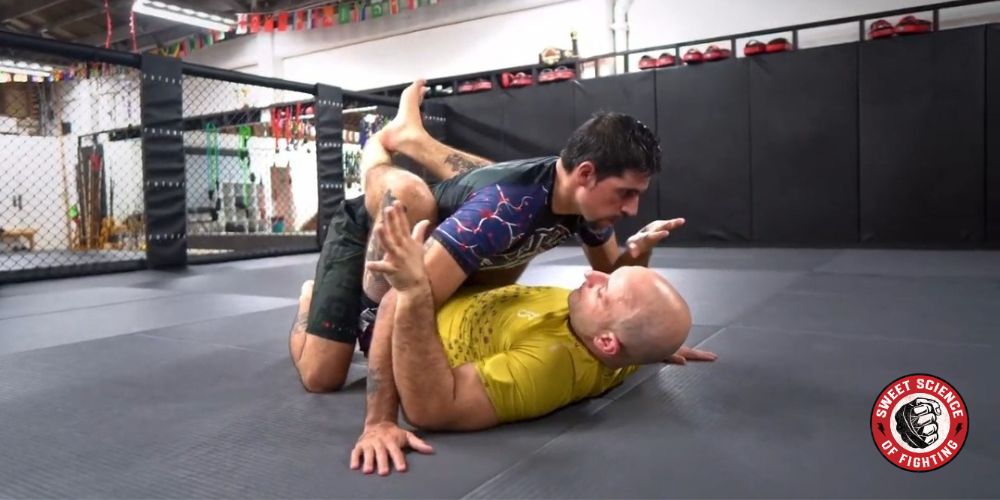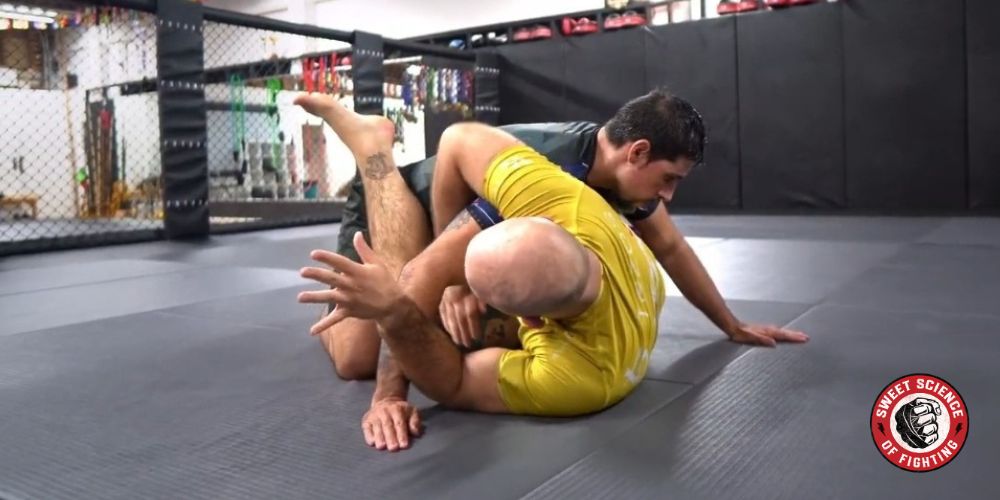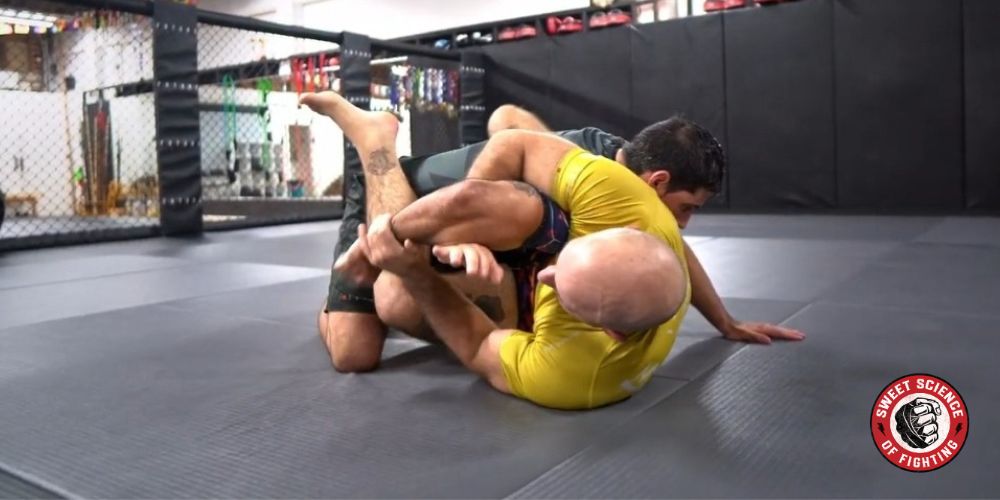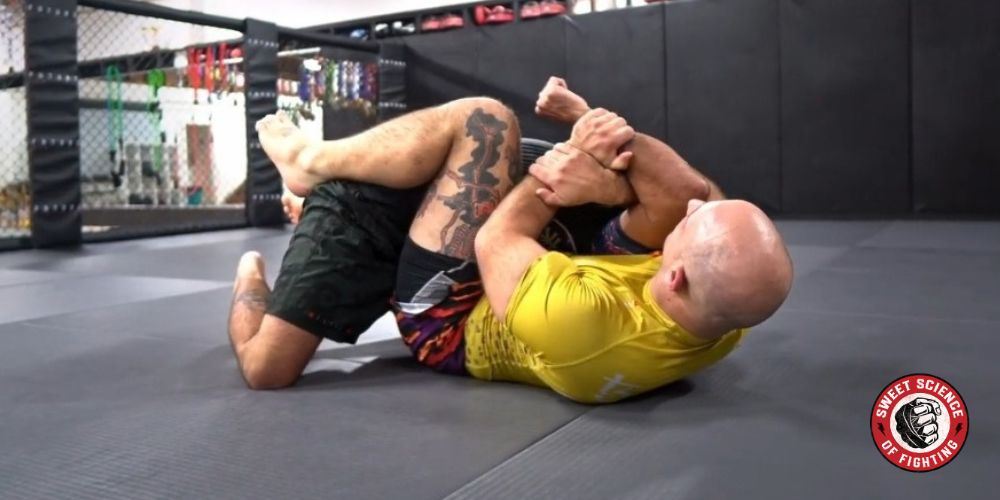The Kimura is an arm & shoulder lock. The technique is also known as a Double Wrist lock in Catch Wrestling or gyaku ude-garami in Judo. In Brazilian Jiu-Jitsu, the submission is known as the Kimura, after Masahiko Kimura, who used the submission to win a grappling match with Helio Gracie in Brazil in 1951.
The Kimura is another pervasive technique throughout grappling arts and can be used from a wide range of positions and in numerous contexts. Find yourself on top? You can find a Kimura. Wrestling? You can find a Kimura. On the bottom? You can find a Kimura!
Mechanically, the technique allows the practitioner to apply braking force to both the elbow and shoulder of their opponent. It’s an effective technique that finds a home in various places!
In this article, we’ll look at how it can be applied and how to apply it effectively.
How To Do a Kimura From Guard (Step By Step)
Step 1: Hands To The Mat

One of the best ways to set up your kimuras is to separate your opponent’s arms or put them on the mat. You can do this by swimming your arms from inside to outside. From here, target the arm you plan to apply the lock to. In this case, I will target his right arm (closest to the camera)
Step 2: Wrap The Arm

Taking my far arm, I reach up and over my uke’s shoulder, wrapping it. The aim here is that I can isolate his shoulder by tucking it under my arm. My hand will now reach back through from the backside to the front.
Step 3: Connect Your Hands

The Kimura works because I’m recruiting both of my arms versus one. Once my wrapping hand reaches through from the back side, it connects to the wrist of my front hand.
My front hand connects to the top of his wrist. This creates the ‘figure four’ arm configuration that the Kimura is so easily identified by.
Step 4: Turn And Apply Force

Now that my hands are connected, I can apply force to his arm and shoulder. I turn his hand back across behind his body. Notice how I’ve turned from my side to my back to help me recruit my posterior chain to apply force through his arm. From here, turn his arm until he taps!
Kimura Lock Defense (How To Escape)
Escaping a locked Kimura is a big challenge. However, you still have some options if your opponent locks one on.
5 Step Blueprint To Build A BJJ Strength Workout To Demolish Your Opposition
Learn how to plan your strength training to maximize transfer to the mats.
Your main priority should be to create distance between yourself and your opponent by posturing and “unwinding” the lock by moving through a plane of motion that relieves the pressure and allows your shoulder to free itself.
If your opponent has control of your hips, however, it will be extremely difficult for you to create the distance to unwind. As always, the best defense is being proactive and having the awareness to deny your opponent the position in the first place.
Kimura Lock Variations
From Side Control
Landing the kimura from side control differs from most of our variations because he has to relinquish control of the hips to create pressure through their arm and shoulder.
You must place your weight correctly, or you risk getting swept. Sprawl heavily towards your leg side of the opponent so that you don’t get turned over your shoulders as you try to apply the lock.
From Mount
From the mount, attempting the kimura without relinquishing the position is less than optimal. One alternative is to turn their arm supine and attack the Americana, a variation of the armlock.
This applies the same kind of pressure to the arm and shoulder without causing you to lose the mount position. Be aware that it doesn’t have the same control implications as the kimura, so there is still a risk of getting reversed here.
From Standing
The kimura can be used from standing as a move in itself or as a counter to their takedown when an opponent leaves an arm vulnerable.
Here’s one example of when we can use the kimura to reverse a takedown position, come out on top, and finish the submission.
This is a perfect example of when the kimura can be used to build control, maintain positional dominance, and create pathways for us to capitalize on a scramble or an opponent’s mistakes.
Frequently Asked Guillotine Choke Questions
Can The Kimura Lock Break The Arm?
Absolutely. The application of the Kimura provides us with the force to break the arm and dislocate the elbow & shoulder.
How Painful Is The Kimura Lock?
Pretty damn painful! Even the most flexible shoulders will only go so far before the pressure applied is either extremely painful or starts to cause damage.
What Happens If You Don’t Tap To A Kimura?
If you don’t tap into a Kimura, you risk injury to your elbow and shoulder. Dislocation of the elbow and shoulder can occur, but bone breaks are not uncommon either.
The radius and ulna are placed under a lot of pressure, the humerus is experiencing significant radial forces, and the shoulder is only held together by ligaments and tendons that can tear or snap.
Both elbow and shoulder joints are being placed under serious pressure and taken through a range of motion that is unnatural. Something will give, and it will not be good when it does!
Summary
To summarize, the Kimura is a highly effective joint lock with devastating potential when applied correctly. It’s not only used as a submission but also as a controlling technique, especially in no-gi jiu jitsu, where grips that allow you control over arm and shoulder are harder to come by.
It’s a versatile technique that can be applied in a wide range of positions. These are the kind of techniques we should aspire to refine, those which have the most utility in many scenarios.
Very rarely will a flashy technique you picked up on social media have the same level of application as the humble fundamentals- which are so often neglected.
Understand a technique’s potential in and of itself and its potential to broaden your game and open up further options through its application.

